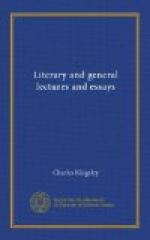Such, we suspect, has been the history of St. George and the Dragon, as well as of Apollo and the Python. It is very hard to have to give up the dear old dragon who haunted our nursery dreams, especially when there is no reason for it. We have no patience with antiquaries who tell us that the dragons who guarded princesses were merely “the winding walls or moats of their castles.” What use then, pray, was there in the famous nether garment with which Regnar Lodbrog (shaggy-trousers) choked the dragon who guarded his lady-love? And Regnar was a real piece of flesh and blood, as King AElla and our Saxon forefathers found to their cost; his awful death-dirge, and the effect which it produced, are well known to historians. We cannot give up Regnar’s trousers, for we suspect the key to the whole dragon-question is in the pocket of them.
Seriously, Why should not those dragons have been simply what the Greek word dragon means—what the earliest romances, the Norse myths, and the superstitions of the peasantry in many parts of England to this day assert them to have been—“mighty worms,” huge snakes? All will agree that the Python, the representative in the old world of the Boa-constrictor of the new, lingered in the Homeric age, if not later, both in Greece and in Italy. It existed on the opposite coast of Africa (where it is now extinct) in the time of Regulus; we believe, from the traditions of all nations, that it existed to a far later date in more remote and barbarous parts of Europe. There is every reason to suppose that it still lingered in England after the invasion of the Cymri—say not earlier than B.C. 600—for it was among them an object of worship; and we question whether they would have been likely to have adored a foreign animal, and, as at Abury, built enormous temples in imitation of its windings, and called them by its name.
The only answer to these traditions has as yet been, that no reptile of that bulk is known in cold climates. Yet the Python still lingers in the Hungarian marshes. A few years ago a huge snake, as large as the Pythons of Hindostan, spread havoc among the flocks and terror among the peasantry. Had it been Ariosto’s “Orc,” an a priori argument from science would have had weight. A marsupiate sea-monster is horribly unorthodox; and the dragon, too, has doubtless been made a monster of, but most unjustly: his




